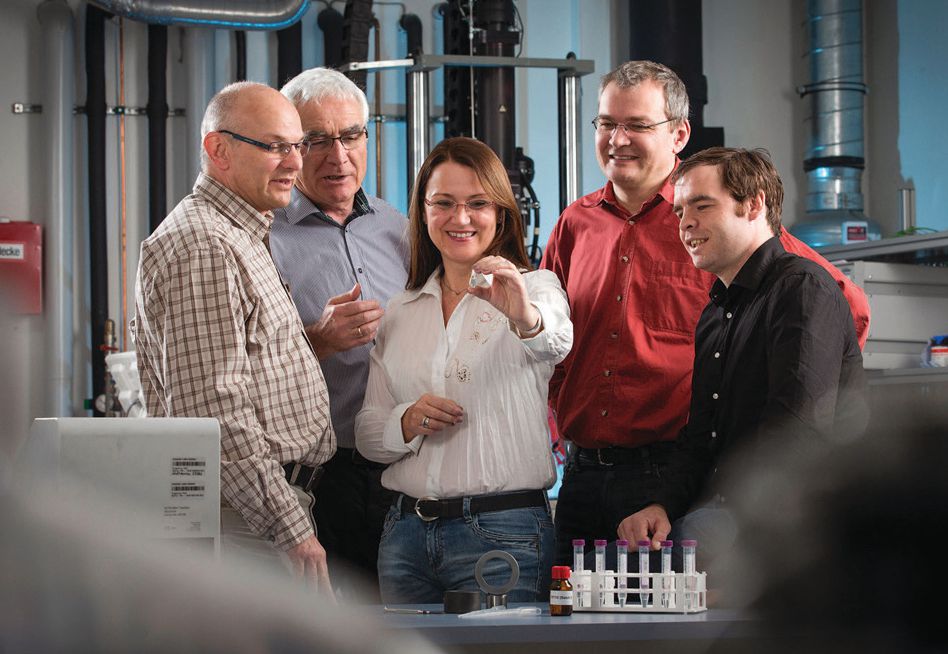Liquid crystals: A new lubricant type
Dr. Neil Canter, Contributing Editor | TLT Tech Beat August 2014
Lubricants have been developed with the potential of using liquid crystals that can minimize friction.
KEY CONCEPTS
•
Liquid crystals have the potential to be used in lubricants because they are able to minimize friction.
•
Based on a reciprocating cylinder-on-disk tribometer test, a liquid crystal based on diketone chemistry displays a lower coefficient of friction than several common lubricants.
•
The liquid crystal lubricant is under evaluation in slide bearing systems.
IF THE QUESTION IS ASKED ABOUT WHAT ARE THE MAIN TYPES OF LUBRICANTS USED COMMERCIALLY, those working in the lubricant industry would most often respond with fluid (or liquid lubricants), greases and solid lubricants. For most of us, fluid lubricants are the most common as they are formulated with a liquid basestock (usually mineral oil) and a set of additives that are chosen based on the application.
Greases range in composition from a semifluid to a solid. They function in a similar manner to a sponge because they contain a three-dimensional network of thickener particles dispersed in a basetock such as mineral oil. Solid lubricants are typically applied to a surface as a powder or thin film and are effective in reducing friction and wear. Several examples include graphite and molybdenum disulfide.
Another state of matter that is in between solids and liquids is known as the liquid crystalline state. Individuals typically associate liquid crystals with electronics. LCDs (liquid crystal displays) are widely used in electronics ranging from calculators to televisions.
Dr. Andreas Kailer, head of Group Wear Protection, Advanced Ceramics, at the Fraunhofer Institute for Mechanics of Materials IWM in Freiburg, Germany, discusses the definition of a liquid crystal. He says, “In the liquid crystalline state, pre-orientations of the molecules lead to direction-dependent properties (e.g., optical, electrical or other properties are different in different directions). Strictly speaking, the term
liquid crystal not only stands for the state of matter but also has become a conventional term for the chemicals that form this state of matter.”
One important characteristic of liquid crystals relevant to lubrication is that they exhibit different viscosities in different directions. This is the key to the development of efficient liquid-crystalline lubricants.
The potential to use liquid crystals in lubricants originates from their ability to minimize friction. When liquid-crystalline structures are sheared between surfaces in a frictional contact at a moderate contact pressure, a reorientation process occurs. The liquid crystalline structure will reorient itself to minimize the resistance against shearing, which leads to a minimization of energy release and, therefore, minimum friction. Perpendicular to the direction of shearing, the viscosity will be higher, which is very helpful to stabilize hydrodynamic lubrication conditions (i.e., separate the surfaces and prevent solid-solid contacts).
The fact that liquid crystal molecules have a rod-like shape enhances their ability to act as lubricants. In a hydrodynamic lubrication regime, the liquid crystal molecules will align in parallel to each other in a very stable orientation. They slide easily over each other, which minimize friction and wear.
The potential for using liquid crystals as lubricants has now been realized. A new class of lubricants has now been developed.
DIKETONE DERIVATIVES
A collaboration among the Fraunhofer Research Institute, Nematel GmbH and Dr. Tillwich GmbH has led to the development of a liquid crystal lubricant prepared by the Claisen condensation of 4-ethylacetophenone with ethylheptanoate (
see Figure 3). The product is known as a diketone but exists in a keto-enol tautomerism that favors the keto-enol form.
 Figure 3. A liquid crystal lubricant was developed and evaluated by a team of researchers who were awarded The Stifteverband Science Prize. (Courtesy of Fraunhofer Institute for Mechanics of Materials IWM)
Figure 3. A liquid crystal lubricant was developed and evaluated by a team of researchers who were awarded The Stifteverband Science Prize. (Courtesy of Fraunhofer Institute for Mechanics of Materials IWM)
The diketone is considered to be a liquid crystal (or a mesogenic fluid) because it exhibits both rigid and flexible parts. Diketones are attractive candidates because they are rather small molecules that can yield very low viscosity coefficients in the liquid-crystalline state. In some cases, diketones were observed not to show liquid-crystalline phases under normal conditions and tend to reorient and form liquid-crystalline domains in frictional contacts.
Diketones are capable of interacting chemically with a steel surface, which leads to tribochemical smoothening during a run-in period and then chemical surface modification.
The researchers have evaluated the diketones in fundamental friction tests using a reciprocating cylinder-on-disk tribometer specially designed to enable analysis of the used lubricant by FT-IR and Raman spectroscopy. Two mesogenic fluids based on diketones were studied at a 1 millimeter stroke at 50 Hz under a load of 50 newtons at a temperature of 90 C. The metal alloy used in the study is 100Cr6 Steel.
Both fluids exhibited a much lower coefficient of friction than a SAE 10W- 40 motor oil ISO 32 gear oil and paraffinic oil.
The researchers studied how a change in the length of the alkyl chain affects the performance of the liquid crystal. The length of the alkyl chains influences the viscosity coefficients, the chemical interaction and the ability to form liquid-crystalline structures. The researchers observed in-lab experiments using reciprocating sliding line-contacts that the level of the lowfriction state varies with the length of the alkyl chain.
Additives to decrease the melting point and to increase the oxidation and corrosion stability were also introduced to improve the performance of the liquid crystal lubricant.
The reason for the low coefficient of friction values is due to a reaction between the liquid crystal lubricant and the steel surface. The interaction of the surface with the liquid crystalline lubricant leads to a grooved structure that supports hydrodynamic conditions. Due to the tribochemical reaction of the mesogenic fluid to a complex with nascent iron atoms, a tribolayer forms on the surface. At moderate contact pressure (< 10 megapascals), there is then as a consequence of the mechanical shear a special alignment of the mesogenic molecules, which leads to minimum friction in the sliding direction.
Future work for the researchers will involve development of slide bearing systems. Applications will be tailored to the liquid crystal lubricants and bearing materials such as 100Cr6 Steel.
Kailer says, “At the moment, we are restricted to lower contact stresses below 10 megapascals. This offers the opportunity to use the liquid crystal lubricants in a large range of sliding bearings. We have started with bearings for electric drives.”
Additional information can be found in a presentation that was given at the 17th International Tribology Colloquium (
1) or by contacting Kailer at
andreas.kailer@iwm.fraunhofer.de.
REFERENCES
1.
Amann. T. and Kailer, A. (2010), “Ultralow friction of reciprocating systems lubricated by mesogenic fluids,” Presented at the 17th International Tribology Colloquium in Ostfildern, Germany, January 19-21, 2010.
 Neil Canter heads his own consulting company, Chemical Solutions, in Willow Grove, Pa. Ideas for Tech Beat items can be sent to him at neilcanter@comcast.net
Neil Canter heads his own consulting company, Chemical Solutions, in Willow Grove, Pa. Ideas for Tech Beat items can be sent to him at neilcanter@comcast.net.